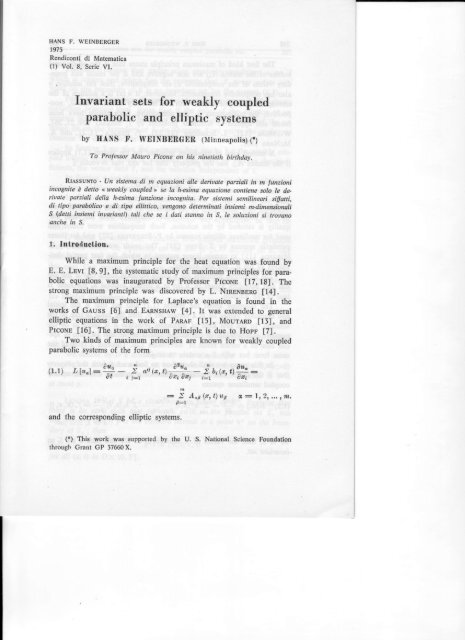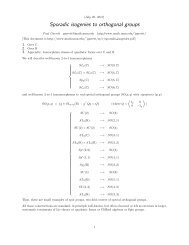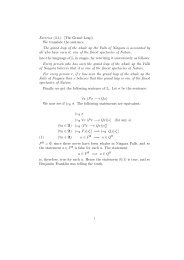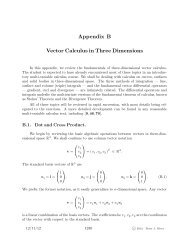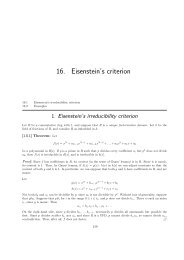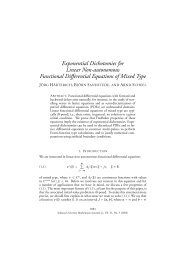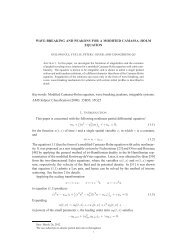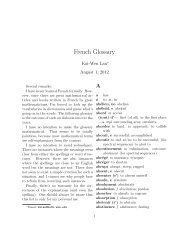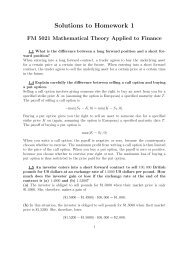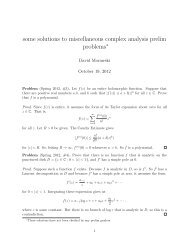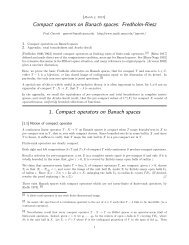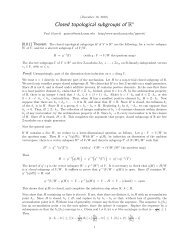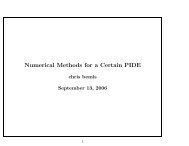Invariant sets for weakly coupled hyperbolic and parabolic systems
Invariant sets for weakly coupled hyperbolic and parabolic systems
Invariant sets for weakly coupled hyperbolic and parabolic systems
You also want an ePaper? Increase the reach of your titles
YUMPU automatically turns print PDFs into web optimized ePapers that Google loves.
IIANS F. WEINBERGER<br />
1975<br />
Rendiconti di Matematica<br />
(l) Vol. 8, Serie VI.<br />
<strong>Invariant</strong> <strong>sets</strong> <strong>for</strong> <strong>weakly</strong> coupld<br />
<strong>parabolic</strong> <strong>and</strong> efli'ptic systemg<br />
by IIANS tr'. WEINBEBOI)B (Minneapolis) (t)<br />
To Prolessor Mauro Picone on his ninetieth birthday,<br />
Rr.lssurro - Un sistema.di m equazioni alle derivate parziali in m lunzioni<br />
incognite d detto < <strong>weakly</strong> coupted > se la h-esima equazione contiene solo le derivate<br />
parziali della h-esima lunzione incognita. Per sistemi semilineari sifiatti,<br />
di tipo,<strong>parabolic</strong>o e di tipo ellittico, vengono determinati insiemi m4imensiotuli<br />
S (detti insiemi invarianti) tali che se i dati stanno in S, le soluzioni si troyano<br />
'anche in S.<br />
1. fntreduction.<br />
While a maximum principle <strong>for</strong> the heat equation was found by<br />
E. E. Lnvr [8, 9], the systematic study of maximum principles <strong>for</strong> <strong>parabolic</strong><br />
equations was inaugurated by Professor Prcor.rB [17, 18]. The<br />
strong maximum principle was discovered by L. NrnnnBERc tf4].<br />
The maximum principle <strong>for</strong> Laplace's equation is found in the<br />
naorks of Gluss [6I, <strong>and</strong> Eanxsnew [4]. It was extended to general<br />
elliptic eguations in the work of Pen^lr [15], Mourano [lj], <strong>and</strong><br />
PrcoNB t161. The strong maximum principle is due to Hopr. t7l.<br />
Two kinds of maximum principles are known <strong>for</strong> <strong>weakly</strong> <strong>coupled</strong><br />
<strong>parabolic</strong> <strong>systems</strong> of the <strong>for</strong>m.<br />
(1.1) Llu,l - *<br />
-,<br />
|raii (a, tt #",-,i<br />
<strong>and</strong> the corresponding elliptic <strong>systems</strong>.<br />
bi(a, q#<br />
: g a"p(rrt)up q,-lr2r,,.rm.<br />
F:l<br />
(!) This work was $pported by the U. S. National Sciencc Foundation<br />
through Grant GP 57660 X,
296 HANS F. WEINBERGER<br />
The first kind of maximum principle states that if the off-diagonal<br />
entries of the matrix A..B ata non negative <strong>and</strong> if the initial <strong>and</strong> boundary<br />
values of the components ua ate nonpositive, then the solution u<br />
also has nonpositive components. Moreover, if u (x) is a solution of the<br />
corresponding elliptic system with the boundary values of the u" nonpositive,<br />
the components u{, ate nonpositive. Such results have been<br />
found <strong>and</strong> applied to nonlinear problems by I.Szensrt 124,25,26f ,<br />
W. Mrer ll2l , | . Scnnonrn 121,221, P. BBseLa ll,2l, <strong>and</strong> A.<br />
McNess t101.<br />
A second kind of maximum principle <strong>for</strong> the system (1.1) applies<br />
if the matrix A"p has the property that <strong>for</strong> any rcal m-vector f<br />
a, f:l<br />
'; a"pl'oEp
t3l <strong>Invariant</strong> <strong>sets</strong> <strong>for</strong> <strong>weakly</strong> <strong>coupled</strong> <strong>parabolic</strong> etc. 2e7<br />
Theorem I shows that under some regularity conditions a set S<br />
which is convex <strong>and</strong> which has the property that t never points outward<br />
on the boundary of s is an invariant set <strong>for</strong> the system (1.2),<br />
For a scalar equation the set S is, of course an interval. The strong<br />
maximum principle then states that if the value of the solution at an<br />
interior point lies on the boundary of S, then all the values of the solution<br />
lie on the boundary of s. In Theorem 2 we prove the analogous<br />
theorem <strong>for</strong> our invariant <strong>sets</strong>.<br />
In Section 3 we give the corresponding<br />
results <strong>for</strong> the <strong>weakly</strong> <strong>coupled</strong><br />
elliptic system which is obtained from (1.2) by making the coefficients,<br />
the vector field f, <strong>and</strong> the sorution independent of t.<br />
In section 4 we show that our theorems may be sharpened by introducing<br />
additional dependent variables whose values are x <strong>and</strong> t.<br />
In Section 5 we present some examples to show that our sufficient<br />
conditions <strong>for</strong> S to be invariant are in some sense also necessary.<br />
We also give some examples to illustrate the application of our results.<br />
It should be noted that while the first kind of maximum principle<br />
also works when the operators on the left of (l.l) depend on s, our<br />
results, like the second kind of maximum principle, do not extend to<br />
this case. Our results also do not contain the above-mentioned generalization<br />
of C. MInaNoe to elliptic <strong>systems</strong> with <strong>coupled</strong> derivatives.<br />
I wish to thank my colleagues Lawrence Markus <strong>and</strong> George Sell<br />
<strong>for</strong> helpful discussions.<br />
9. Parnbolie systemr.<br />
We beging with a simple lemma which contains the basic idea of<br />
our results.<br />
We denote by D a domain in R" with closure D.<br />
If S is a closed convex set in R-, we shall denote by So k>0)<br />
the parallel set of all points in R' whose euclidean distance to S is<br />
at most p,<br />
Lnunae l. Let s be a closed convex subset of R*. suppose that<br />
there is an e)0 such that <strong>for</strong> each pe(O,e) the parallel set Sn has<br />
.the property that if yr fs the outward normal at a point rr* on the boun-<br />
'dary<br />
ol Sn , then<br />
(2.1) p.f (u*, n,t) 1O<br />
lor all (x, t) in D X (0, fl.
HANS F. WEINBERGER<br />
If n is any solution of the <strong>parabolic</strong> system (1.2) in D X (0, TI<br />
wnil i! alt timit points o! n(x,t) as (x,t) approachrt DxtO) or 0DX<br />
X [0,T] <strong>and</strong>, il D is unbounded, as lxl+"" with (x,t)eDX (0'?l<br />
lie in S, then u (x, /) eS in PX (0, Tl.<br />
Pnoor'. Suppose that <strong>for</strong> some (x,t)eDX (0, ?1, u(x, f) is outside<br />
S. Then u (x, /) is also outside So <strong>for</strong> some p€(0,€). By continuity<br />
there is a point (xo,t*)eDX(0, fl such that u (x, r)eS, <strong>for</strong> (x,t) e<br />
eDX (0, t*l <strong>and</strong> u*- tt (x*, /*)e 6Sn . Let p be the outward normal<br />
to OSn at u*. Then by hypothesis p'f (u*, **,t*) < 0 '<br />
On the other h<strong>and</strong>, since ^S,<br />
is convex, the function p'tr (x, /) attains<br />
its maximum value in DX(0, /"1 at (x*, f*). There<strong>for</strong>e at (x*,t*)<br />
p.Enl3t2 0, D'6uf \n,i: O <strong>for</strong> i: \,.,.,n'<br />
<strong>and</strong> the matrix p.O2a/\xiilxi is negative semidefinite. A st<strong>and</strong>ard argument<br />
shows that p .Z aii02u/0xi0xi is nonpositive. Thus it follows<br />
from (1.2) that p.f (uo,xo,fo)>0, which contradicts (2.1). We conclude<br />
that u(Af) cannot lie outside S <strong>for</strong> (x,t)eDX (0,?1, which<br />
proves the lemma.<br />
If we make some smoothness assumptions about the system (1.2)<br />
<strong>and</strong> the domain Do we can replace the conditions (2.1) on the boundaries<br />
of a whole family of parallel <strong>sets</strong> by the weaker condition<br />
(2.2) p .f (u*, u, t) 1Q <strong>for</strong> (n, fi e D x (0 ' ?l<br />
on the boundary of S.<br />
It can be seen from the work of EIoBL'MAN [5, especially Theorcm<br />
4.4f that if<br />
(a\ t is uni<strong>for</strong>mly <strong>parabolic</strong> <strong>and</strong> its coefficients are uni<strong>for</strong>mly<br />
Holder continuous with Holder exponent greater then l/2, <strong>and</strong><br />
(b) the boundary 0D is of class Ct", ve (0,1) <strong>and</strong> the vector<br />
field f is uni<strong>for</strong>mly Holder continuous in x <strong>and</strong> t <strong>and</strong> Lipschitz conti'<br />
nuous in u <strong>for</strong> (x, t)eDX (0, Tl, then <strong>for</strong> any bounded Holder continuous<br />
initial values u (x, 0) in D <strong>and</strong> boundary values tr on 0 D X [0'?]<br />
the system (1.2) has a unique bounded solution in DX (0, ?l which is<br />
continuous in D x [0, T]. Moreover, if D is unbounded, this solution is<br />
the limit of the solutions up of initial-boundary value problems on<br />
DfiBnX (0,?l with rrp=11 at t:0 <strong>and</strong> on 0 DfiBnX (0,f1 <strong>and</strong> with<br />
any uni<strong>for</strong>mly bounded smooth data given on D n a BnX (0, fl ' Bn<br />
denotes the ball {"t lx l
t5I <strong>Invariant</strong> <strong>sets</strong> <strong>for</strong> <strong>weakly</strong> <strong>coupled</strong> <strong>parabolic</strong> etc.<br />
Tsronpu 1. Let s be a crosed convex subset ol R^ with the pro-<br />
,perty tlnt <strong>for</strong> any outward normal p at any boundary point n* s1 s the<br />
ineqwlity (2.2) is satisfied.<br />
Let the operator L satisfy the above hypothesis (a), <strong>and</strong> la D <strong>and</strong><br />
f satisfy hypothesis (b).<br />
If tr(x,t) is any solution of $.2) in Dx(O, Tl which is continuous<br />
in D x [0, Tf , <strong>and</strong> if the values ol , on Dx { ol <strong>and</strong> on oDx [O,TJ<br />
are bounded <strong>and</strong> Hiilder continuous <strong>and</strong> lie in s, then u (a t)es in<br />
Dx (0,<br />
rl.<br />
Pnoor. For any point w of R- which lies outside s there is a unique<br />
point q(w) on 0S which is closest to w. Of course, w-q(w) is an<br />
outward normal to 0 S at q(w). We define<br />
The vector field g is Hcilder continuous in x <strong>and</strong> t <strong>and</strong> Lipschitz continuous<br />
in w. Assume first that D is bounded. By hypothesis there is a<br />
unique solution w of the problem<br />
Lw:g(w,o,t) in DX(0, T), w (o,0):u(r,0), w(u,t)lao: u(o,t) l3r.<br />
It is easily ,r.n thut if w* is a boundary point of the parallel set<br />
Sn, then p:wr-tl(w*) is an outward normal vector to 0 Sn at n* <strong>and</strong> to<br />
0 S at q (w*). Hence<br />
p.g (w*, u, t) : (w* - q (w*)).f (w', nrt) - | ** -- q (w*) lu S - p,<br />
because of (2,2). There<strong>for</strong>e the parallel <strong>sets</strong> of s satisfy (2.1) with<br />
respect to the vector field g. Then Lemma 1 shows that w (x, t)eS in<br />
px (0, rl.<br />
(f(w,o, l; if w€,S<br />
g (wr ort): I ( f(q(w),o, r)-w *<br />
q (w) if w( S.<br />
If D is unbounded, w is the limit of solutions wn in DflBnX(O,?1,<br />
whereril*=uon DflB*X{O} <strong>and</strong> on ADnBnX[0,f], <strong>and</strong> waon<br />
DnA tsnX (0, rl is taken to be smooth <strong>and</strong> uni<strong>for</strong>mly bounded <strong>and</strong><br />
to lie in S. 'By the above argument each wn lies in S. Since S is closed,<br />
the limit w lies in S.<br />
Since g(u, x,t)-f(u,r,f) <strong>for</strong> ueS,w is a bounded solution of<br />
the system (1.21 with the same initial <strong>and</strong> boundary data asu. A st<strong>and</strong>ard<br />
uniqueness theorem shows thatu-w.<br />
<strong>and</strong> the theorem is proved.<br />
Hence u(At)eS in DX(0,T1,
HANS F. WEINBERGER<br />
Note that if f is independent of x <strong>and</strong> t, the condition (2.2) means<br />
that the set S is invariant with respect to increasing / under the flow<br />
daldt= f (u).This system is obtained from (1.2) by deleting the terms<br />
involving second partial derivatives.<br />
This system is obtained from (1.2) by deleting the terms involving<br />
second partial derivatives.<br />
In order to <strong>for</strong>mulate a strong maximum principle we shall need<br />
the following definition.<br />
Den'rnttrov. The boundary point u* of S is said to satisly a slab<br />
eondition if there is a neighborhood N of an in R^ with the lollauting<br />
property.<br />
There is a Cr one-to-one mapping M with Ct inverse of N i S onto<br />
a set ol the torm<br />
I z1 t tz r,,., xz,-L, a : (t, t,,. t trm-L\ E K,<br />
such that<br />
(a) Mu*eKx{0},<br />
(b) M n eKX{O} -> ue0S<br />
0(o
<strong>Invariant</strong> <strong>sets</strong> <strong>for</strong> <strong>weakly</strong> <strong>coupled</strong> <strong>parabolic</strong> etc.<br />
We see from the chain rule <strong>and</strong> (1.2) that ..<br />
(2.3) Llvl:<br />
2,ffOln(u,<br />
o,,) -,, S*,<br />
",f:,o', #,<br />
where tt is, of course, to be evaluated at (x, t).<br />
Since the mapping M gives the r p as functions of<br />
write<br />
tp (0t t) - q (u (rr l))'<br />
The inverse mapping M-r allows us to write ll as a<br />
Tb ,,, t Tm-r <strong>and</strong> a. Then<br />
6uo<br />
0*r:<br />
*it duo 0t" , 6uo 6E<br />
i,r, a.rT<br />
"1,<br />
ao a*o'<br />
Because the surfaces d= constant are convex, the matrix<br />
(2.4)<br />
is negative semidefinite. Hence<br />
g -,-*- a:'" aY|<br />
a, f:L ltco 6up 0h }rn<br />
n m m-t<br />
32a<br />
Z Z 2 aiji,<br />
!-l a, d:l r, F-L }Uu EttP<br />
We then see from (2.3) that<br />
6Uo }un 0t,%-o.<br />
6t" 6 i,rt ar, -'<br />
:.j<br />
6ttn }up<br />
ar.6 a"r'<br />
301<br />
u, we may<br />
function of<br />
(z.b) fr tel - Ltql * 0,3*, ",f:,o,t #J, :' # #,+ * #,\.<br />
'Y (n'<br />
#,=z<br />
o' t\: E(u' c' t)'<br />
#(u)'f"<br />
We again consider lt as a function of r <strong>and</strong> a which, in turn, are<br />
functions of x <strong>and</strong> f. We define the function<br />
Eb,r.t)-\<br />
/ rto k @, r),0 ), 0,t) *<br />
t-.<br />
I<br />
I + _L [.E' (u (t (u, t), I lat t\\ o, t) - I (rr (z (r, ,), 0 ), n, t\l<br />
9luta)<br />
I <strong>for</strong> O(o
HANS F. WEINBERGER t8l<br />
Then (2.5) shows that g satisfies the uni<strong>for</strong>mly <strong>parabolic</strong> differential<br />
inequality<br />
(2.6) L l2l> E (s', n, t)<br />
in Dr X(h, t*f .<br />
Since the points where o:0 lie on the boundary of S <strong>and</strong> since<br />
0o/0u" is an inward normal at such a point, it follows from (2.2) that<br />
Thus (2.6) implies that<br />
.a(or u,t) --t u:^1")<br />
"f" (u, n,t\ / o.<br />
(2.7) frfvl> E (V, r, t) - E (0 , o, t).<br />
Moreover, cp>O in DrX(fi, t*l <strong>and</strong> g (x*, t*);=9.<br />
By construction H (o, A /) is Lipschitz continuous in o. Since g is<br />
bounded in any closed subset DzX ltz, t*f of Dr X(tr, t*7, there is a<br />
constant c so that I H
tel <strong>Invariant</strong> <strong>sets</strong> <strong>for</strong> <strong>weakly</strong> <strong>coupled</strong> <strong>parabolic</strong> etc.<br />
tion of finitely many convex <strong>sets</strong> with C2<br />
boundaries intersect at nonzero angles.<br />
boundaries, provided the<br />
2. If u * lies on the intersection of several c boundary components<br />
which rneet at nonzero angles, the proof of Theorem 2 applied<br />
to each piece separately shows that if tr(x*,/*):u*, then rr(Ar) lies<br />
on the,intersection of these components in Dx(g, f*1. Thus if we think<br />
of 0s as a curvilinear polyhedron, u is confined to one of the faces,<br />
edges, or vertices of S.<br />
3. If the Gaussian curvature of 0S is never zero, then the matrix<br />
(2.4) is negative definite. Since g=0, the inequality in (2.7) cannot be<br />
strict. There<strong>for</strong>e 0r, f 0xi-0 <strong>for</strong> all v <strong>and</strong> i at any point (x*, f*) where<br />
tr(x*,r*)e0s. since also 0g/0xi=0 at such a point, we conclude that<br />
in this case a solution u (a.t) which lies on 0S must be independent<br />
of. x.<br />
4. The above proof is easily extended to show that if (1.2,) holds<br />
in an arbitrary domain R of the (a /) space, if u (a t)es in R, <strong>and</strong> if<br />
u (x*, r*)eOs, then u (x, t)eOs at all points which can be reached from<br />
(x*, fn) by a path in R along which f never increases.<br />
3.'Elllptle <strong>systems</strong>.<br />
If the coefficients <strong>and</strong> the function f in (1 .z) are independent of<br />
f, we may consider the corresponding uni<strong>for</strong>mly elliptic system<br />
(B.t) M[u,J- - ; av @)3+ - ; b,@)*" r,-- .\<br />
d, j-l<br />
' da1 dfri o:l oi:J-o(uro)<br />
d':l'",fii'<br />
By using essentially the arguments tfat were used to prove Theo<br />
rem 1, one establishes the following theorem about a solution u of (i.1)<br />
in a domain D.<br />
' T""o*nu 3. Let s be a closed convex subset of R^ with the property<br />
that if p is any outward normal to 0S at a boundary point a*,<br />
tlpn<br />
p.f(ttr,r)
HANS F. WEINBERGER<br />
Let t be a solution of the system (i.1), <strong>and</strong> let its boundary va-<br />
Iues lie in S. Then u (x) eS <strong>for</strong> all x in D.<br />
Since a solution of (3.1) is also a solution of the corresponding <strong>parabolic</strong><br />
system (1.1), Theorem 2 yields the following result.<br />
Tseonena 4. Let s be a closed convex subset of R^, <strong>and</strong> let every<br />
point of the boundary satisly a slab condition. Let f (rr,x) be Lipschitz<br />
continuous in v, <strong>and</strong> suppose that any outward normal p at any boundary<br />
point u* ol s satisfies the inequality p.f (u*,x)
tl 1I lnvariant <strong>sets</strong> <strong>for</strong> <strong>weakly</strong> <strong>coupled</strong> <strong>parabolic</strong> etc.<br />
points of interest are those of the relative boundary in R'xDx(0,r1.<br />
The proof of Theorem I gives the foilowing extension.<br />
TsBonru 5. Let the domain D, <strong>and</strong> the operator<br />
hypotheses of Theorem l. Let h (x, t), ... , bn (x, t) <strong>and</strong><br />
Lipschitz continuous in all their variables.<br />
Let S be a relatively closed subset of R*XDX(O,TJ . Suppose that<br />
each point,i* ,l the relative boundary i ol<br />
^i in R*XDX(g,T1 has<br />
a neighborhood whose intersection with 3 i, ,on ex <strong>and</strong> that any out-<br />
ward normat ] ot i* satisfies the inequality<br />
(4.3)<br />
p.f (u*)<br />
< 0.<br />
L satisly the<br />
f (t, x, t) be<br />
ff u rs a solution in Dx (0, Tl ol (4.2) whose initial <strong>and</strong> boundary<br />
values tie in 3, then i .,3 in Dx (0, Tl.<br />
We remark that if ScR- satisfies the conditions of Theorem !,<br />
then the set S=sxDx(O,r1 satisfies the conditions of Theorem 5.<br />
The set $nn-x{(a r)} in which u(x, r) may lie may depend upon<br />
the point (x, t). There<strong>for</strong>e Theorem 5 may give more in<strong>for</strong>mation than<br />
Theorem 1 even if the vector field f is independent of x <strong>and</strong> t.<br />
The reduction to the system (4.2) can also be used to extend the<br />
other theorems, but we shall not do so here.<br />
we note that by (4.s) a subset ,3 of R,xpx(O, T] is an invariant<br />
set <strong>for</strong> (4.2) if it is locally convex on its relative boundary <strong>and</strong><br />
invariant wifh respect to increasing time under the flow<br />
(4.4) ihtldt: f (ur o,t)i d,t6lilt: - b;(c,t), d - 1r...,n.<br />
These are the equations which can be used to solve the system<br />
which is obtained from (4.2) by discarding the second derivative rerms<br />
of. L (that is, the difrusion terms).<br />
6. Exnmples <strong>and</strong> eounterexnmples.<br />
In this section we shall give some examples to illustrate the implications<br />
of our results.<br />
The requirement of convexity makes it difficult to find invariant<br />
<strong>sets</strong> s. The first example shows that the convexity is needed.
306 HANS F. WEINBERGER<br />
Exanapre<br />
l. Let m:2, n:!, <strong>and</strong> consider<br />
the following problem<br />
(5.1) +-#:0, #-#--o<br />
tt'r(frt0) : rt2(-n,O):<br />
0 <strong>for</strong> n30<br />
n <strong>for</strong> 0 (r(, 1<br />
1 <strong>for</strong> u 2l,<br />
since f:0, the condition p.f
t13l lnvariant <strong>sets</strong> <strong>for</strong> <strong>weakly</strong> <strong>coupled</strong> <strong>parabolic</strong> etc. 307<br />
Exlvprp 3. The cylinder S={n:ur2*ttz2=1, hef_1, 1l } satisfies<br />
the conditions of Theorem 2 with respect to the system<br />
0*,<br />
_ 02ut<br />
_ ^.<br />
Ow, 6ru, _ 6us }ru,<br />
At-ffi:1t2, Af-fF:-ut, i-M-0.<br />
The Gaussian curvature vanishes on the side as well as on the top <strong>and</strong><br />
bottom of this cylinder. A solution on 0s is given by u1=sin f, uz=eos t,<br />
<strong>and</strong> us(x,t) any solution of the heat equation with values in (_1, l).<br />
Thus u need not be independent of x.<br />
We shall now give some examples of invariant <strong>sets</strong> S in the case<br />
when fqu,ort)-,4u, where A is a constant mxm matrix. We recall<br />
that a closed convex set S is an invariant set if <strong>and</strong> only if it is invariant<br />
with respect to increasing / under the flow.<br />
(5.2) duldt: .4.u.<br />
Thus, if s contains an initial point of a trajectory of. (5.2), it must contain<br />
all points of the trajectory with t>0.<br />
It is known [5, S 56, Theo. 2'l that the flow (5.2) has bounded<br />
invariant <strong>sets</strong> with interior if <strong>and</strong> only if all the eigenvalues of A have<br />
nonnegative real parts <strong>and</strong> no nonlinear elementary divisors correspond<br />
to any eigenvalue with real part zero. Let s be the matrix<br />
such that S-t AS is the |ordan canonical <strong>for</strong>m but with the usual ones<br />
above the diagonal of each |ordan block replaced by the real part of<br />
the corresponding eigenvalue. It is easily verified that the positive<br />
definite matrix R=Res*-rs-r has the property that u.RAu
308 HANS F. WEINBERGEN t14l<br />
set S=R^:r.DX(0,f] n{u,x, t)z lurl
t15l <strong>Invariant</strong> <strong>sets</strong> <strong>for</strong> <strong>weakly</strong> <strong>coupled</strong> <strong>parabolic</strong> etc. 309<br />
BIBLIOGRAPHY<br />
TU P. Bssare: On solutions ol Fourier's<br />
linear <strong>parabolic</strong><br />
ftrst problem lor<br />
equationsin<br />
an unbounded<br />
13 (1963)<br />
domain.<br />
pp. 241-265.<br />
T2] P.<br />
Besare: Concerning solutions of an<br />
f1r a system o! non-linear <strong>parabolic</strong><br />
(1964) pp. 289-J01.<br />
a systeftT ol non-<br />
Ann. Polon. Math.<br />
exterior boundary-value problem<br />
equations. Ann, polon. Math. 14<br />
t3l w. e. coppBr: stability <strong>and</strong> Asymptotic Behavior ol Differentiar Equa_<br />
tions. D. C. Heath, Boston, 1965.<br />
t4l s' Eannsunw: on the nature or the morecurar<br />
constitutio"<br />
<strong>for</strong>ces which regurate the<br />
^o_f . ,the ruminilerous ether. cambridge phil.<br />
(1859) pp.<br />
soc.<br />
97-r12.<br />
Trans. 7<br />
t5l s' D' EroEL'MeN: paraboric<br />
<strong>systems</strong>. North-Holl<strong>and</strong>, Amsterdam, 1969.<br />
t6l<br />
c' F. G.cuss: Alrgemeine Theorie des Erdmagnetismus. Beobachten des<br />
magnetischen vereins im |ahre rgig, Leipzig, 1gi9. Also in werke<br />
(Collected Works) 5, p. 129.<br />
t7l E. Hopr: Elementare Bermerkungen ilber die Ldsungen partieller<br />
rentialgleichungen Diffe-<br />
zweiter Ordung vom elliptischen<br />
der preuss. Typus. Sitzungsber.<br />
Akad. der Wissenschaften 19 (1927) pp. r47-r52.<br />
t8l E. E. Lpvr: Sull'equazione del calore. Reale Accad. dei Lincei,<br />
diconti (5)<br />
Roma.<br />
t62 (1907)<br />
Ren-<br />
pp. 450-456.<br />
t9l E. E. Lpvr: surl'equazione der carore. Annali di Mat. pura ed Appr. t4<br />
(1908) pp. 187-264.<br />
t10l A' McNans: comparison <strong>and</strong> existence theorems lor multicomponent diflusion<br />
svstems. f. of Math. Anal. <strong>and</strong> Applic. i (196r) pp. rs3-r44.<br />
l11l c' MrnaNo'l: sttl teorema del massimo modulo per una classe di sistemi<br />
ellittici di equazioni del secondo ordine e per le equazioni a coefficienti<br />
complessi' Istituto Lombardo-Accademia Ji scienze e Lettere. Rendiconti<br />
(A) 104 (1970) pp. 136_745.<br />
tl2l W. Mrer: DifJerential inequalities ol <strong>parabolic</strong><br />
(1957) pp. J49-354.<br />
type. Ann Polon. Math. J<br />
[15] T' Moureno: Notes sur les dquations aux d6riv6es partielles, I. de l,Ecole<br />
Polytechnique 64 (1g94) pp. 55_69.<br />
Ll4l L. NrnpNsnnc: A strong maximum principle<br />
lor <strong>parabolic</strong> equatiors Comm.<br />
on Pure <strong>and</strong> Applied Math. 6 (195j) pp. r67-t77.
310 TIANS F. WEINBENGEN<br />
t15l A. P.mar: Sur le probldme de Dirichlet et son extension au cas de l'6quation<br />
lindaire g4ndrale du second ordre. Annales de la Facult6 des Sciences<br />
de Toulouse (I) 6 (1392) H, pp. 1-75.<br />
t16l M. Prcoxr: Maggiorazione degli integrali di equazioni lineari ellittico<strong>parabolic</strong>he<br />
alle derivate parziali del secondo ordine. Accad. Naz. dei Lincei.<br />
Atti Rendiconti (6) 5 (1927) pp. 138-143.<br />
[17] M. PIcoNB: Maggiorazione degli integrali delle equazioni totalmente <strong>parabolic</strong>he<br />
alle derivate parziali del secondo ordine. Annali di Mat. Pura<br />
ed Applic. (4) 7 (1929) pp. 145-192.<br />
t18l M. Ptcotn: SUI problema della propagazione del calore in un mezzo privo<br />
di frontiera, conduttore, isotropo, € omogeneo. Math. Ann. 101 (1929)<br />
pp. 701-712.<br />
[19] M. H. PnorrBn-H. F. WrINnencrn: Maximum Principles in Differential<br />
Equations. Prentice-Hall, Englewood Cliffs, N. J., 1967.<br />
t20] D. H. SemtNcBn: A nonlinear parabolb system in the theory ol combustion.<br />
Quarterly of Applied Math. (in prin$.<br />
l2ll l. Scnndosn: Invers-monotone Operatoren Arch. <strong>for</strong> Rat. Mech. <strong>and</strong> Anal.<br />
10 (1962) pp. 276-295.<br />
1221 I. Scrn6oBn: Monotonie-Eigenschaften bei Difierentialgleichungen Arch. <strong>for</strong><br />
Rat. Mech. <strong>and</strong> Anal. 14 (1963) pp. 58-60.<br />
l23J T. Srvs: On the unique solvability ol the first Fourier problem lor a parobolic<br />
system ol linear difrerential equations ol second order. Prace<br />
Mat. 9 (1965) pp. 283-289.<br />
l24l I. Szrnsrr: Sur la limitation et I'unicitd des solutions d'un systbme nonliniaire<br />
d'1quations paraboliques aux ddrivdes partielles du second ordre.<br />
Ann. Polon. Math. 2 (1955) pp. 237-249.<br />
r25l<br />
126l<br />
l27l<br />
J. Szmsrr z Sur un systbme non-lindaire d'indgalitds dift€rentielles paraboliques.<br />
Ann Polon. Math. 15 (1964) pp. 15-22.<br />
I. Szensrr: Differential Inequalities. Polish Scientific Publishers, Warsaw,<br />
1965.<br />
P. Szrprvcrt: Existence theorem lor the first boundary value problem lor<br />
a quasilinear etliptic system. Acad. Polon. des Sciences, Bulletin 7 (1959)<br />
pp. 419-424.<br />
Pervenuto in Redazione il 16 novembre 1974.<br />
Tipografia " Oderisi ,, Editrice Gubbio 1975<br />
t16l


